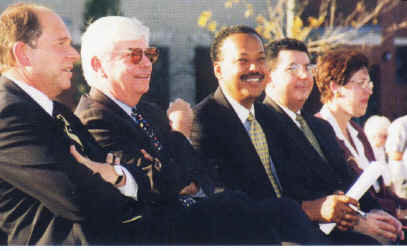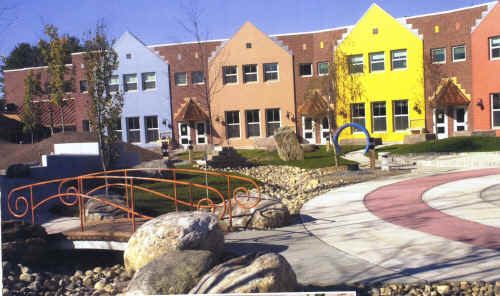| TRINITY REPORTER |
The Learning Corridor
|
- The Learning
Corridor opens for learning
- New schools, new hope for Trinity's neighbors
- On the outside, the buildings of the Learning Corridor are impressively
shiny and new, like a monument to the vision of those who can imagine a bright future for
Hartford's children. On the inside, the facilities are teeming with the energy of those
children. A little more than three years after ground was broken, the Learning Corridor
opened for the business of learning. In September, the first groups of students began
attending classes in the educational complex adjacent to Trinity's campus, a complex that
includes:v
the Montessori Magnet School, for
children ages 3 to 12;
v the Hartford Magnet Middle School, featuring
interdisciplinary teams of teachers and a curricular emphasis on the arts and sciences;
v the Greater Hartford Academy of Math and
Sciences, serving students from grades 9 through 12 with advanced courses and
independent learning experiences in mathematics, science, and technology; and
v the Greater Hartford Academy of the Arts, attended by
students from more than 40 school districts for afternoon courses and programs in music,
drama, dance, and creative writing.
 A. Montessori Magnet School
A. Montessori Magnet School
- B. Hartford Magnet Middle School
C. Commons Building
D. Greater Hartford Academy of Math and Science
E. Greater Hartford Academy of the Arts
F. Boys & Girls Club at Trinity College
-
Plans for the Learning Corridor were first unveiled by
President Dobelle in January 1996, following a landmark decision by Trinity's Board of
Trustees to commit $5.9 million from the College's endowment to launch a bold $175-million
neighborhood revitalization plan. Dobelle, quoted in a recent issue of The New York
Times, says, "We wanted the whole community to buy into the idea that their kids
could be anything they want." Trinity's partners in the Southside Institutions
Neighborhood Alliance (SINA)--Hartford Hospital, Connecticut Children's Medical Center,
the Institute of Living, and Connecticut Public Television and Radio--matched Trinity's
initial contribution with an additional $5 million. Supported by both the State of
Connecticut and the City of Hartford, the $110.8-million Learning Corridor project was
launched officially with a groundbreaking ceremony in July 1997.
During a visit to the Learning Corridor this October, U.S. Senator Joseph Lieberman called the Corridor "an
imaginative experiment in learning, a real innovation, and a real opportunity for families
throughout the Hartford area."
 Dedication ceremonies were held at a community open house on October
13. Among those present were (from right of Dobelle) U.S. Senator Christopher Dodd,
Assistant Secretary for Community Planning and Development Cardell Cooper from the U.S.
Department of Housing and Urban Development, Hartford Superintendent of Schools Anthony
Amato, and Capitol Region Education Council Executive Director Marcia Yulo. Also
attending were U.S. Representative John Larson and Commissioner Ted Sergi of the
Connecticut Department of Education.
Dedication ceremonies were held at a community open house on October
13. Among those present were (from right of Dobelle) U.S. Senator Christopher Dodd,
Assistant Secretary for Community Planning and Development Cardell Cooper from the U.S.
Department of Housing and Urban Development, Hartford Superintendent of Schools Anthony
Amato, and Capitol Region Education Council Executive Director Marcia Yulo. Also
attending were U.S. Representative John Larson and Commissioner Ted Sergi of the
Connecticut Department of Education.
President Dobelle, who took the role of master of ceremonies
at the dedication, called the opening of the Learning Corridor this fall "a historic
event for the Hartford community and its children. The Learning Corridor is proof that
citizens and community groups, working together with a local college, business leaders,
other nonprofit organizations, foundations, and local, state, and federal governments, can
create positive and lasting change."
 Earlier that day in a separate ceremony, Dobelle presented Governor
John G. Rowland (between Dobelle and Kevin Sullivan'71, vice president for community and
institutional relations, and Thomas Johnson '62, chair of Trinity's Board of Trustees),
who was not able to attend the community open house, with a President's Medal for
Excellence, the highest honor awarded to individuals who are not alumni of the College. In
honoring Rowland, Dobelle acknowledged the governor's "quiet, consistent,
unequivocal, and exemplary" leadership on the project. For his part, Gov. Rowland has
called the Learning Corridor "one of the most successful urban redevelopment projects
in Connecticut." He said, "I'm especially proud of the way Trinity, the city,
and the state were able to work together, using education as a catalyst. I'd love to use
the Learning Corridor as a model for what can be accomplished in each of our major
cities."
Earlier that day in a separate ceremony, Dobelle presented Governor
John G. Rowland (between Dobelle and Kevin Sullivan'71, vice president for community and
institutional relations, and Thomas Johnson '62, chair of Trinity's Board of Trustees),
who was not able to attend the community open house, with a President's Medal for
Excellence, the highest honor awarded to individuals who are not alumni of the College. In
honoring Rowland, Dobelle acknowledged the governor's "quiet, consistent,
unequivocal, and exemplary" leadership on the project. For his part, Gov. Rowland has
called the Learning Corridor "one of the most successful urban redevelopment projects
in Connecticut." He said, "I'm especially proud of the way Trinity, the city,
and the state were able to work together, using education as a catalyst. I'd love to use
the Learning Corridor as a model for what can be accomplished in each of our major
cities."
This year about 800 students, from pre-kindergarten to 12th
grade, are attending classes and participating in programming in the Learning Corridor.
Three years from now, when the Learning Corridor is operating at full capacity, it is
expected to serve more than 1,400 children from Hartford and 44 of its neighboring
communities.
A substantial, and very positive, article in The
New York Times on October 29, 2000, reported on the early successes of the Learning
Corridor. In it, reporter Stacey Stowe noted that the Corridor "has become a symbol
of renewal and of what one college can do for its community." She went on to say that
"when asked about the neighborhood, the first thing residents point out is the
Learning Corridor as the most potent symbol of change."

The article concluded with President Dobelle's challenge to
other schools to become involved in their communities. "We're trying to do the right
thing. We're sending a signal to other colleges that asks, do you or don't you do the
right thing." The Times also covered another aspect of the Trinity/SINA
neighborhood initiative in a November 1, 2000 story on the "smart neighborhood"
project, which enables neighborhood residents and organizations to gain access to
computers and the Internet through a program operated by the College and funded by the
W.K. Kellogg Foundation.
"Focused on a Hartford neighborhood where 31 percent of
the residents live below the poverty level and 28 percent of the households receive some
form of public assistance, the planning process for [the Learning Corridor] had to look
beyond the bricks and mortar of new development and address key destabilizing factors of
the neighborhood," notes Eddie A. Perez, SINA's president and executive director and
a Trinity IDP alumnus. "One of the biggest challenges for the neighborhood is its
education infrastructure, which the Learning Corridor addresses."
"Being part of the Learning Corridor is a
once-in-a-lifetime experience, and a change we're making that's going to affect a whole
generation," said Hyacinth Yennie, then-president of Hartford Areas Rally Together
(HART), a community-based organization that has played a key role in the neighborhood
initiative from the outset. "The Corridor has put new light and a new vitality into
our neighborhood. There's still a lot of work that needs to be done, but this is a
wonderful new beginning."
Read
Evan S. Dobelle, "This Is Hartford's Triumph," an op-ed in
The Hartford Courant,
September 3, 2000.
Read The
Hartford Courant's editorial, "Hartford's
Education Jewel," September 7, 2000.
Back to table of contents
 A. Montessori Magnet School
A. Montessori Magnet School Dedication ceremonies were held at a community open house on October
13. Among those present were (from right of Dobelle) U.S. Senator Christopher Dodd,
Assistant Secretary for Community Planning and Development Cardell Cooper from the U.S.
Department of Housing and Urban Development, Hartford Superintendent of Schools Anthony
Amato, and Capitol Region Education Council Executive Director Marcia Yulo. Also
attending were U.S. Representative John Larson and Commissioner Ted Sergi of the
Connecticut Department of Education.
Dedication ceremonies were held at a community open house on October
13. Among those present were (from right of Dobelle) U.S. Senator Christopher Dodd,
Assistant Secretary for Community Planning and Development Cardell Cooper from the U.S.
Department of Housing and Urban Development, Hartford Superintendent of Schools Anthony
Amato, and Capitol Region Education Council Executive Director Marcia Yulo. Also
attending were U.S. Representative John Larson and Commissioner Ted Sergi of the
Connecticut Department of Education. Earlier that day in a separate ceremony, Dobelle presented Governor
John G. Rowland (between Dobelle and Kevin Sullivan'71, vice president for community and
institutional relations, and Thomas Johnson '62, chair of Trinity's Board of Trustees),
who was not able to attend the community open house, with a President's Medal for
Excellence, the highest honor awarded to individuals who are not alumni of the College. In
honoring Rowland, Dobelle acknowledged the governor's "quiet, consistent,
unequivocal, and exemplary" leadership on the project. For his part, Gov. Rowland has
called the Learning Corridor "one of the most successful urban redevelopment projects
in Connecticut." He said, "I'm especially proud of the way Trinity, the city,
and the state were able to work together, using education as a catalyst. I'd love to use
the Learning Corridor as a model for what can be accomplished in each of our major
cities."
Earlier that day in a separate ceremony, Dobelle presented Governor
John G. Rowland (between Dobelle and Kevin Sullivan'71, vice president for community and
institutional relations, and Thomas Johnson '62, chair of Trinity's Board of Trustees),
who was not able to attend the community open house, with a President's Medal for
Excellence, the highest honor awarded to individuals who are not alumni of the College. In
honoring Rowland, Dobelle acknowledged the governor's "quiet, consistent,
unequivocal, and exemplary" leadership on the project. For his part, Gov. Rowland has
called the Learning Corridor "one of the most successful urban redevelopment projects
in Connecticut." He said, "I'm especially proud of the way Trinity, the city,
and the state were able to work together, using education as a catalyst. I'd love to use
the Learning Corridor as a model for what can be accomplished in each of our major
cities."